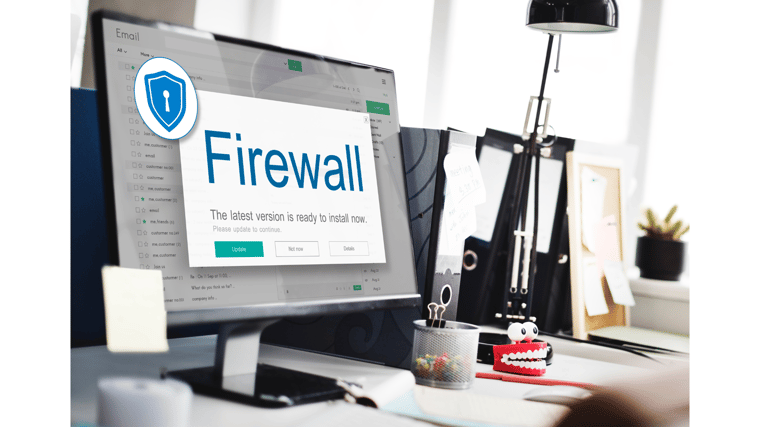Installing a firewall is one of the most essential tools against these cyber threats. Implementing the right type and configuring it effectively can reduce the risk of unauthorized access, data breaches and cyber attacks. So how do you choose the best firewall? What are the different types? And what benefits do firewalls offer?
Read: 3 Reasons Your Business’ Firewall Isn’t Enough
What Are Firewalls?
A firewall is a network security device that protects your network by monitoring, filtering and controlling incoming and outgoing traffic at your device’s entry point, or port; it essentially acts as a barrier or gatekeeper between your secure private internal network and external networks, including the internet. Most firewalls are the first line of defense to protect the network and data against unwanted or unauthorized traffic.
This traffic is filtered based on predetermined security policies to permit or block data packets (pieces of data for internet transfer) based on various factors: source and destination IP addresses, contents, port numbers, packet and application protocols, specific keywords, etc. Only trusted sources or IP addresses are allowed into your network, which helps identify threats and malicious attempts.
Different Generations of Firewalls
Firewalls constantly evolve and have undergone several transformations since they first emerged.
- Gen 1 Virus: This firewall was released in the late 1980s to protect stand-alone PCs from viruses and consisted of antivirus protections.
- Gen 2 Networks: These were introduced in the mid-1990s to protect business networks from internet attacks.
- Gen 3 Applications: The third wave was released in the early 2000s and led to the creation of Intrusion Prevention Systems Products to protect businesses from application vulnerabilities.
- Gen 4 Payload: Released about 2010, this firewall protects businesses affected by targeted, unknown, evasive and polymorphic cyber attacks.
- Gen 5 Mega: The newest firewall was introduced in 2017 to provide advanced threat detection and prevention solutions to businesses facing multi-vector and mega attacks.
Types of Firewalls
There are two main types of firewalls, with several sub-types. The different types incorporate methods of filters, and each operates at a different level.
The two main types are hardware firewalls and software firewalls.
- Hardware firewalls (network firewalls): These are physical equipment positioned between your device and the internet or network connection. This firewall protects multiple devices and provides additional defense against attacks. However, they often require trained professionals for configuration and maintenance.
- Software firewalls (host firewalls): Most device operating systems include a built-in software firewall, as they can regulate and control traffic through port numbers and applications. However, most software firewalls are located on the same system that needs protection, which can hinder their ability to stop malicious activity.
From these two types, several firewall sub-types exist, including:
- Packet filtering firewalls
- Stateful and stateless inspection firewalls
- Proxy firewalls
- Application layer firewalls
- Unified threat management (UTM) firewalls
- Next-generation firewalls (NGFW)
- Virtual firewalls
- Cloud firewalls
- Circuit-level gateway firewalls
Firewall Benefits
Firewalls come with several benefits for organizations that implement them.
- Enhanced network security: Firewalls are the first line of defense against unauthorized access and cyber attacks, preventing hackers from infiltrating and stealing your data.
- Strong traffic control: By defining the rules for network traffic filtering, you can manage bandwidth usage and prioritize critical applications.
- Protect against threats and attacks: Firewalls help block incoming and outgoing connections with malicious IP addresses and domains, minimizing the risk of malware and phishing Please note that firewalls protect against malicious traffic and not directly against malware.
- Data loss prevention: Firewalls can prevent sensitive information from leaving your network and reduce the likelihood of data breaches and downtime.
- Cybersecurity compliance: Firewalls can also help organizations meet their cybersecurity compliance requirements by implementing the necessary network security measures.
Firewall Best Practices
Proper setup and maintenance of your firewall are essential to keeping your network, devices and data safe.
- Update your firewalls regularly: Firmware and software patches help keep your firewall safe against new vulnerabilities and risks.
- Use antivirus and antimalware: Since firewalls can’t directly protect against malware, you need protection from these threats.
- Limit access and hosts: You can guarantee better protection by limiting the inbound and outbound connections, reducing user access privileges and default to connection denial for inbound traffic. Enable access only when needed.
- Implement data backups: To further help prevent data loss and downtime, you should use data backup solutions.
- Perform regular audits: With any security protocol, regularly check for vulnerabilities and risks so your IT team can address them before a major problem occurs.
Thriven Can Help Protect Your Data
At Thriveon, we understand how crucial is to keep your network, devices and data secure. That's why we offer cybersecurity compliance services so you can protect your company while meeting regulations.
Schedule a meeting with us today.


